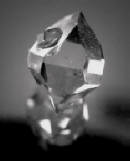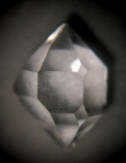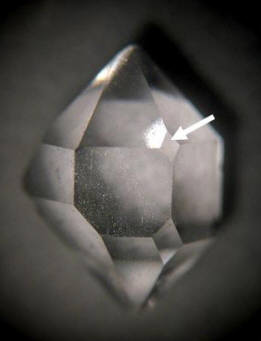
Best Website for Herkimer Diamond Information
Last Updated:

About this Webpage:


Free Website Where Herkimer Diamond Enthusiasts Share Information with the Public
Scroll down
Dr.C. did two talks at the Herkimer Diamond Festival (July)which are in a Youtube movie. The research on the Herkimer District is in need of samples and photos.
How can you help? Visit the "how to help" page.



Herkimer diamonds are a mineral called quartz. Quartz occurs in many different shapes (habits) and colors throughout the Herkimer mining district. On this page you will find photos of the different types of quartz, along with links to more detailed photos and explanations. Any theory that seeks in explaining the formation of Herkimer diamonds must take into account all the different quartz habits observed within the Herkimer mining district.
Click on the words in red below to go to another Herkimer webpage.
Quartz Photo Page - The Various Habits of Quartz in the Herkimer Diamond Mining District.


Herkimer Diamond "Singles" - what the district is famous for!

Herkimer Diamond singles in matrix - on the host rock


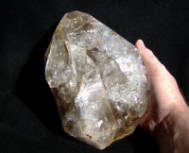
Each crystal is 1.5 cm long. Note the changes in shape. These are the crystals common for the Herkimer diamond mining district. (Photo, Dr.C. 2007). Crystals from DA.
A perfect crystal, like the one on the left, has a certain form to it (see discussion below). Sometimes you can get the right form but it will have an inclusion. The crystal on the right has a "baby floater". (Click on photo to go to the original source)
Sometimes the single crystals can get quite large, but when they do they are heavily fractured, with the field name "goonie", as shown in the two photos above. The maximum size for an unfactured single crystal appears to be 4 cm tip-to-tip. (Photos Dr.C., 2007). Crystals from DA.


Herkimer Diamond "Singles" - The question of form: its not just about 18 faces.
A perfect Herkimer diamond with "good form" has a certain set of faces that are visable, like the photos to the left and right here. Arrows point to the characteristic face. (Photos: click on the left photo to link to its original sources)
The question is, should a Herkimer diamond have"good form", some similarity to this form with an extra face, in order to be called a Herkimer diamond of "perfect form"? The photo on the right has one half of the prism faces (p) and one half of the termination faces (r) labeled. The extra face is in two places like the photo on the left.
Photos of "Herkimer diamonds", in a wide variety of forms (habits), are illustrated at the bottom of this page. Is everything to be called a Herkimer diamond?
Herkimer diamonds on host rock is the second most common occurence within the Herkimer district. They can occur in variety of ways, but the most common is within small vugs, or holes in the rock, found in "vug zones". This is shown in the photo to the left. The vug is lined with tiny dolomite crystals coated with hydrocarbon.

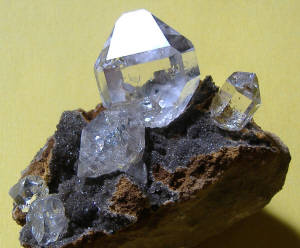
Some times the Herkimer diamond will grow on very angular host rock, as in the example below (with scattered dolomite crystals), different from the rounded pockets with smooth rock. But what is unusual here is how pristine the host rock is. (Specimen donated by Frank, 2010 - Photo, Dr. C.).
Herkimer diamonds will grow on top of host rock that is lined with quartz that is called "druze", from a druze zone, as in the example to the right, which is "baby floater druze".
Herkimer Diamonds as groups of crystals - almost always restored
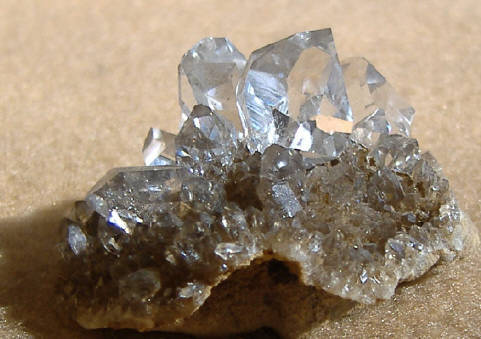
Another example of Herkimer diamonds growing on top of druze. This time the druze is seperated from the host rock.
Herkimer Diamonds in a range of colors
How to write your label? Some different crystal shapes (habits). Are these all Herkimer diamonds?

A question proposed here is "What crystals do we call Herkimer diamonds?"
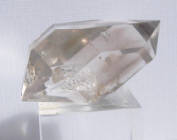
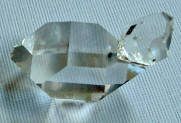
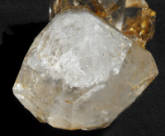
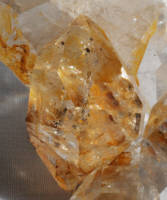
Clear
White
Champange
Golden

Golden Red
Photo from Geoff, 2011
Specimen donated by Mike Hoisington
Specimen donated by Frank
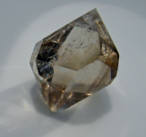
Smoky
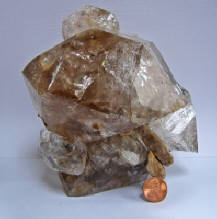
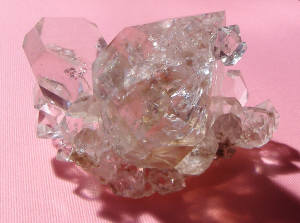



Cumberland Habit
Dauphine Habit
Black
"Hawk Nose" Habit
By permission from Frank
Parallel Growth Habit
A tight group of small crystals, more than 50 along the base, and all intact. The larger crystals were restored. Group from DA
An elongated, or linear, group. Specimen donated by Frank, 2010. Group from AD.

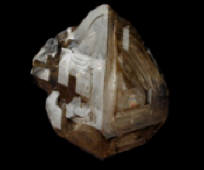



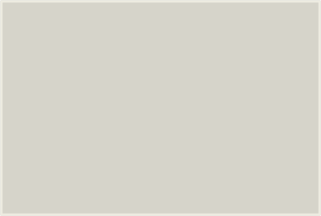
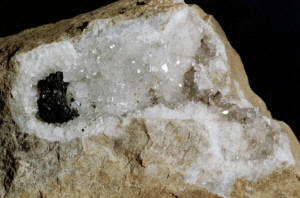
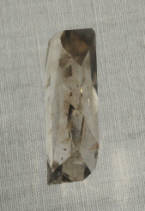
These crystal shapes (habits) are all from the Herkimer district. Perhaps more of a descriptor is needed in the specimen label, for example:
Herkimer diamond: Cumberland Habit or
Quartz - Herkimer diamond: Cumberland Habit.
Some people prefer to use the term quartz in their specimen label others do not. The term "Herkimer diamond" is not a variety of quartz (like amethyst) but rather a trade or locality name. Some people prefer to restrict the use of the term strictly to quartz from the Herkimer mining district, which seems appropriate. The question of restricting its use also to crystal habit is one that is being posed here.
W. David Hoisington, Ph.D.

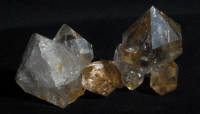
May, 2012
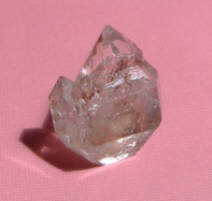

Another characteristic of Herkimer diamonds of "good form" is a shift in the alignment of the prism faces. This can be seen in the photo on the left where the top of the prisim face is shifted up and down (just above the letter p).
"Good form" is also represent by a fairly equal size in all the faces, except the extra one, again shown in the photo on the upper left.
The question of "What is a perfect Herkimer diamond?" is not just about clarity but about form.
Send a photo of your perfect Herkimer diamond and we will add it to the "Perfect Herkimer Diamond" page.


2r
3r
